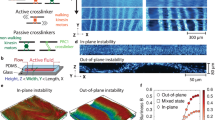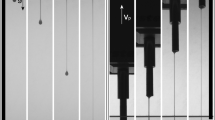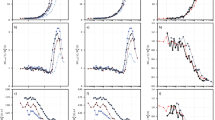Abstract
Entangled polymer solutions and melts exhibit elastic, solid-like resistance to quick deformations and a viscous, fluid-like response to slow deformations. This viscoelastic behaviour reflects the dynamics of individual polymer chains driven by brownian motion1: since individual chains can only move in a snake-like fashion through the mesh of surrounding polymer molecules, their diffusive transport, described by reptation2,3,4, is so slow that the relaxation of suddenly imposed stress is delayed. Entangled polymer solutions and melts therefore elastically resist deforming motions that occur faster than the stress relaxation time. Here we show that the protein myosin II permits active control over the viscoelastic behaviour of actin filament solutions. We find that when each actin filament in a polymerized actin solution interacts with at least one myosin minifilament, the stress relaxation time of the polymer solution is significantly shortened. We attribute this effect to myosin's action as a ‘molecular motor’, which allows it to interact with randomly oriented actin filaments and push them through the solution, thus enhancing longitudinal filament motion. By superseding reptation with sliding motion, the molecular motors thus overcome a fundamental principle of complex fluids: that only depolymerization makes an entangled, isotropic polymer solution fluid for quick deformations.
This is a preview of subscription content, access via your institution
Access options
Subscribe to this journal
Receive 51 print issues and online access
$199.00 per year
only $3.90 per issue
Buy this article
- Purchase on Springer Link
- Instant access to full article PDF
Prices may be subject to local taxes which are calculated during checkout




Similar content being viewed by others
References
Doi, M. & Edwards, S. F. The Theory of Polymer Dynamics (Clarendon, Oxford, 1986)
de Gennes, P. G. Reptation of a polymer chain in the presence of fixed obstacles. J. Chem. Phys. 55, 572–579 (1971)
Perkins, T. T., Smith, D. E. & Chu, S. Direct observation of tube-like motion of a single polymer chain. Science 264, 819–822 (1994)
Käs, J., Strey, H. & Sackmann, E. Direct visualization of reptation for semiflexible actin filaments. Nature 368, 226–229 (1994)
Taylor, D. L. & Condeelis, J. S. Cytoplasmic structure and contractility in amoeboid cells. Int. Rev. Cytol. 56, 57–144 (1979)
Reisler, E., Smith, C. & Seegan, G. Myosin minifilaments. J. Mol. Biol. 143, 129–145 (1980)
Niederman, R. & Pollard, T. D. Human platelet myosin. J. Cell Biol. 67, 72–92 (1975)
Sinard, J. H. & Pollard, T. D. Acanthamoeba myosin II minifilaments assemble on a millisecond time scale with rate constants greater than those expected for a diffusion limited reaction. J. Biol. Chem. 265, 3654–3660 (1990)
Verkhovsky, A. B., Svitkina, T. M. & Borisy, G. G. in Cell Behaviour: Control and Mechanism of Motility (eds Lackie, J. M., Dunn, G. A. & Jones, G. E.) 207–222 (Biochem. Soc. Symp. 65, Portland Press, London, (1999).
Honda, H., Nagashima, H. & Asakura, S. Directional movement of F-actin in vitro. J. Mol. Biol. 191, 131–133 (1986)
Kron, S. J. & Spudich, J. A. Fluorescent actin filaments move on myosin fixed to a glass surface. Proc. Natl Acad. Sci. USA 83, 6272–6276 (1986)
Gupta, R. K. Polymer and Composite Rheology, 2nd edn (Marcel Dekker, New York, 2000)
Wachsstock, D. H., Schwarz, W. H. & Pollard, T. D. Cross-linker dynamics determine the mechanical properties of actin gels. Biophys. J. 66, 801–809 (1994)
Morse, D. C. Viscoelasticity of concentrated isotropic solutions of semiflexible polymers. 2. Linear response. Macromolecules 31, 7044–7067 (1998)
Isambert, H. & Maggs, A. C. Dynamics and rheology of actin solutions. Macromolecules 29, 1036–1040 (1996)
Liverpool, T. B., Maggs, A. C. & Ajdari, A. Viscoelasticity of solutions of motile polymers. Phys. Rev. Lett. 86, 4171–4174 (2001)
Bray, D. Cell Movements (Garland, New York, 1992)
Straub, F. B. Actin II. Studies Inst. Med. Chem. Univ. Szeged 3, 23–27 (1943)
Adelstein, R. S., Godfrey, J. E. & Kielly, W. W. G-actin: preparation by gel filtration and evidence for double stranded structure. Biochem. Biophys. Res. Commun. 12, 34–38 (1963)
MacLean-Fletcher, S. D. & Pollard, T. D. Viscometric analysis of the gelation of Acanthamoeba extracts and purification of two gelation factors. J. Cell Biol. 85, 414–428 (1980)
Margossian, S. S. & Lowey, S. Preparation of myosin and its subfragments from rabbit skeletal muscle. Methods Enzymol. 85, 55–71 (1982)
Käs, J. et al. F-Actin, a model polymer for semiflexible chains in dilute, semidilute, and liquid crystalline solutions. Biophys. J. 70, 609–625 (1996)
Nedelec, F. J., Surrey, T., Maggs, A. C. & Leibler, S. Self-organization of microtubules and motors. Nature 389, 305–308 (1997)
Acknowledgements
We thank M.E. Chenevert for providing a commercial fluid rheometer, and J. Prost for help with the interpretation of the results. We also thank the following for discussions; H. Swinney, C. Moncman, F. Jülicher, A. Maggs, T. Liverpool, D. Morse, J. Guck, D. Martin, P.A. Janmey, F. Brochard, K. Browning and P.G. de Gennes.
Author information
Authors and Affiliations
Corresponding author
Ethics declarations
Competing interests
The authors declare that they have no competing financial interests
Supplementary information
Rights and permissions
About this article
Cite this article
Humphrey, D., Duggan, C., Saha, D. et al. Active fluidization of polymer networks through molecular motors. Nature 416, 413–416 (2002). https://doi.org/10.1038/416413a
Received:
Accepted:
Issue Date:
DOI: https://doi.org/10.1038/416413a
This article is cited by
-
3D printed protein-based robotic structures actuated by molecular motor assemblies
Nature Materials (2022)
-
Mechanical regulation of bone remodeling
Bone Research (2022)
-
Effects of extracellular matrix viscoelasticity on cellular behaviour
Nature (2020)
-
Cortical cell stiffness is independent of substrate mechanics
Nature Materials (2020)
-
Structural and mechanical remodeling of the cytoskeleton maintains tensional homeostasis in 3D microtissues under acute dynamic stretch
Scientific Reports (2020)
Comments
By submitting a comment you agree to abide by our Terms and Community Guidelines. If you find something abusive or that does not comply with our terms or guidelines please flag it as inappropriate.



